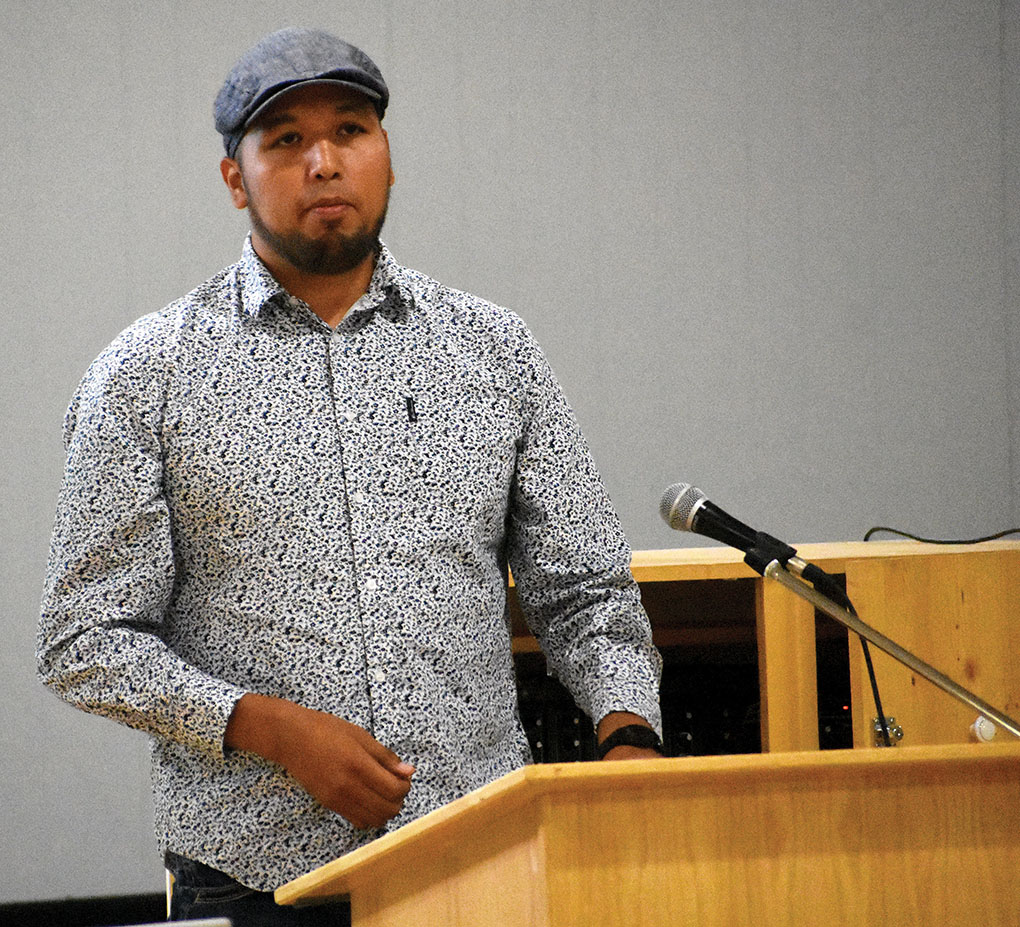Key developments in First Nations history
Posted on September 21, 2021 by Maple Creek TONY CAPPO
TONY CAPPOTony Cappo’s mother has a hard time being around his daughter.
The sight of the little girl triggers memories of what happened to her at a similar age – being dropped off on the steps of a residential school.
Cappo (pictured), a member of the Muscowpetung Saulteaux Nation, Treaty 4, north east of Regina, spoke about this part of his family experience during a presentation on Indigenous economics.
With the help of a slideshow, he took his audience through a painful history lesson, recounting “genocidal tactics” used by the Canadian government towards Indigenous peoples.
“It has been a tough road,” he said, adding: “I didn’t make any of this up. It all happened.”
Cappo, who has served two terms as chief of Muscowpetung First Nation, said the way forward for Indigenous people was a balance between education and spirituality.
On this page are some key developments in Indigenous people’s history, which Cappo highlighted in his slideshow.
For reasons of space we had to omit many landmark moments.
IMPACTS TO FIRST NATIONS ECONOMIC DEVELOPMENT
Since time immemorial Indigenous Peoples maintained a sacred connection to Mother Earth with political, legal, social, and economic systems developed in accordance with the laws of the Creator.
Wanuskewin archaeological evidence confirms that Indigenous Peoples inhabited what is now known as Saskatchewan for more than 10,000 years.
Royal Proclamation
Royal Proclamation issued by King George III recognizes Indigenous title to lands in the “New Americas”.
The War of 1812
The War of 1812 saw an alliance of British and Indigenous Peoples defeat the Americans.
The residential school era begins in the east
First residential schools start in Eastern Canada.
1850
Smallpox epidemic decimates Indigenous peoples.
1850
Indian Protection Act
Defined Indians as having the same rights as children.
1867
British North America Act gave the federal government responsibility over Indians and their lands.
1871-1873
Treaties 1, 2 and 3 are signed. Treaties were negotiated with the intent to share the land while Indians would maintain their way of livelihood and autonomy.
1874
Treaty 4 is signed.
1875
Treaty 5 is signed at Norway House. The treaty and its 1908 adhesion cover approximately the northern two-thirds of Manitoba.
1876
Treaty 6 is signed.
1876
Indian Act federal legislation passed to assert federal authority over Indians. This Act mposed policies such as enforced economic transitions, cultural destruction, assimilation and the Pass/Permit system.
1879
Assimilation tactics
John A. MacDonald charges Nicolas Davin to research boarding schools for Indians in the US. Both the US and Canadian governments were focused on assimilating the “Indian” and solving the “Indian Problem”.
1879
The disappearance of the last of the buffalo occurs, changing the livelihood of First Nations and Metis people forever.
1881
Amendments to the Indian Act reduced competition between Indian and non-Indian farmers.
1883
The first residential schools opened in the north-west in 1883 and 1884 in Qu’Appelle, High River and Battleford.
1886
The pass system
Books of passes were sent to Indian agencies. As the system evolved, Indians were required to carry passes for all activities outside their reserves.
1895-1927
One-third of all lands reserved for Indians under the numbered treaties are removed from reserve status by the federal government.
1899
Treaty 8 is signed and covers northwest section of what is now known as Saskatchewan.
1906
Treaty 10 in the northeast section of the province is signed. This treaty, influenced by the terms of Treaty 8, provides rights for hunting, trapping and fishing.
1910
Amendment to Indian Act prevents Indian bands from using trust funds to pay for legal counsel for land claims.
1917
Soldier Settlement Act – Indian veterans could not apply to the Soldier Settlement Board; instead they were issued location tickets, which merely carved out an parcel of reserve land for them.
1919
National Indian Brotherhood is created to be the first national organization to promote Indigenous rights.
1930
Natural Resource Transfer Agreement transferred rights to natural resources to provincial governments.
1951
Revisions to the Indian Act make it legal for Indians to hire a lawyer to make land claims, and to practise their cultural traditions. Eliminated the pass system, however, Indian Agents utilized the Pass System until the mid-1960s.
1960s
Provincial jurisdiction is allowed on reserves in some areas. Social Services began apprehending children and adopted then to non-Aboriginal families as a form of implementing the assimilation policy. This is commonly known as the “60s Scoop”.
1960
Indians are given the right to vote in federal elections and provincially in Saskatchewan Indians are recognized as “Humans” by John G. Diefenbaker government.
1969
White Paper is proposed as part of the “Just Society” by the Trudeau Government to eliminate the Department of Indian Affairs, abolish the Indian Act, remove Status and end the treaty process.
1985
Bill C-31 is enacted by Parliament of Canada. This Bill restored the status and band membership to First Nation women who lost their status due to marrying non-Native men as outlined in the Indian Act.
1992
Saskatchewan Treaty Land Entitlement Framework Agreement – defines the process for purchasing back lands owed to First Nations under treaty obligation. Twenty-five First Nation bands and the provincial and federal governments signed the agreement. In Saskatchewan over one million acres of land was returned through TLE Agreement.
1996
The last federally run residential school in Canada, the Gordon School, closes in Saskatchewan.
2007
Premier Brad Wall mandates that treaty education be mandatory in all grades in all Saskatchewan schools.
2010
Canada adopts the United Nations Declaration on the rights of Indigenous Peoples with qualifications on its application, stating Canada strongly supports these principles.
2015
The summary of the report from the Truth and Reconciliation Commission is released with recommendations made to help repair the relationship between the federal government and First Nations people.


Leave a Reply
You must be logged in to post a comment.